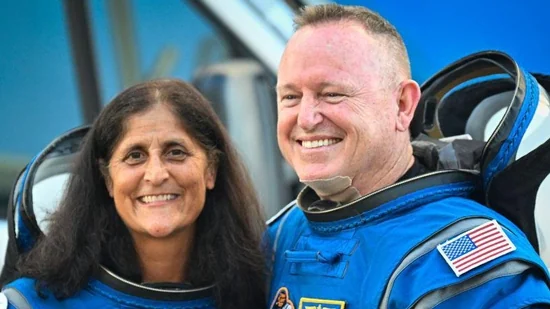Butch Wilmore and Indian-origin Sunita “Suni” Williams, known around the world as the stranded astronauts, completed six months in space on Thursday, with two more months to go. On June 5, the two launched into orbit, the first people to be aboard Boeing’s new Starliner crew capsule, on what was to be a week-long test flight.
They arrived at the International Space Station the next day, only after overcoming a series of thruster failures and helium leaks. NASA deemed the capsule too risky for a return flight, so it will take until February before their long and arduous mission ends.
NASA managers loathe calling them stranded or stranded, while the two retired Navy captains ignore the details of their plight. They insist they are fine and accept their fate.
Wilmore sees it as a kind of detour: “We’re just on a different path.” “I love everything about being here,” Williams told students at an elementary school named after her in her hometown of Needham, Massachusetts, on Wednesday. “Being in space is a lot of fun.”
Both astronauts have been there before, so they quickly became full-fledged members of the crew, helping with science experiments and doing things like fixing broken toilets, vacuuming air vents and watering plants. Williams took over as station commander in September.
“Mindset matters a lot,” Wilmore said in response to a question from Nashville first-graders in October. He is from Mount Juliet, Tennessee. “I don’t see situations like that in life as hopeless.”
Boeing sent its Starliner capsule home empty in September, and NASA sent Wilmore and Williams on a SpaceX flight that wasn’t scheduled to return until late February. Two other astronauts were removed to make room and maintain a six-month schedule for crew rotation.
Like other station crews, Wilmore and Williams trained for spacewalks and any unexpected situation.
“When crews go up, they know they could be up there for up to a year,” NASA Associate Administrator Jim Free said.
NASA astronaut Frank Rubio learned this when the Russian space agency had to rush a replacement capsule for him and two astronauts in 2023, extending their six-month mission to just over a year.
Boeing said this week that information from Wilmore and Williams has been “invaluable” in its investigation of what went wrong. The company said in a statement that it is preparing for Starliner’s next flight, but declined to comment on when it might launch again.
NASA has also heaped high praise on the pair.
“Whether it was luck or choice, they were wonderful people for this mission,” Dr. J.D. Polk, NASA’s chief health and medical officer, said during an interview with The Associated Press.
On top of everything else, Williams, 59, has had to deal with “rumors,” as she calls them, that she has lost too much weight. She insists she weighed the same as she did on launch day, which Polk confirms.
During the student chat Wednesday, Williams said she didn’t have much of an appetite when she first arrived in space. But now she is “very hungry” and eats three meals and snacks a day, while exercising for two hours daily.
Williams, a long-distance runner, uses the space station treadmill to support races in her home state. She competed in Cape Cod’s 7-mile Falmouth Road Race in August.
She also competed in the 2007 Boston Marathon. She has a New England Patriots shirt for game days, as well as a Red Sox spring training shirt. “Hopefully I’ll be home before that happens — but you never know,” she said in November. Husband Michael Williams, a retired federal marshal and former naval aviator, is in Houston taking care of their dogs.
For Wilmore, 61, he’s missing his younger daughter’s senior year in high school and his older daughter’s theater productions in college.
“We can’t deny that being unexpectedly separated, especially during the holidays when the whole family is together, increases the desire to share time and events together,” his wife, Deanna Wilmore, told the AP in a text message this week. Her husband’s “situation is even worse than ours” because he is confined to the space station and can only connect via video for short periods of time.
